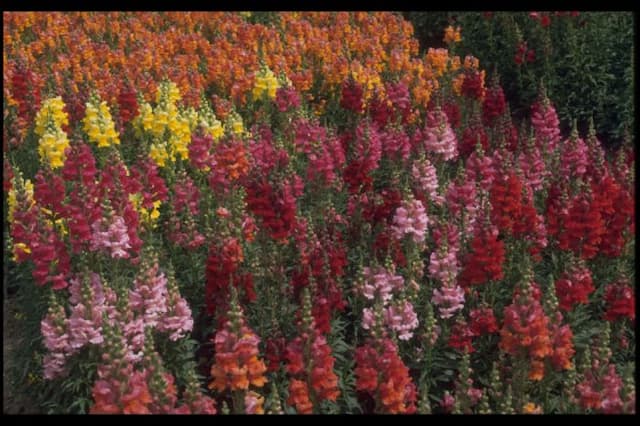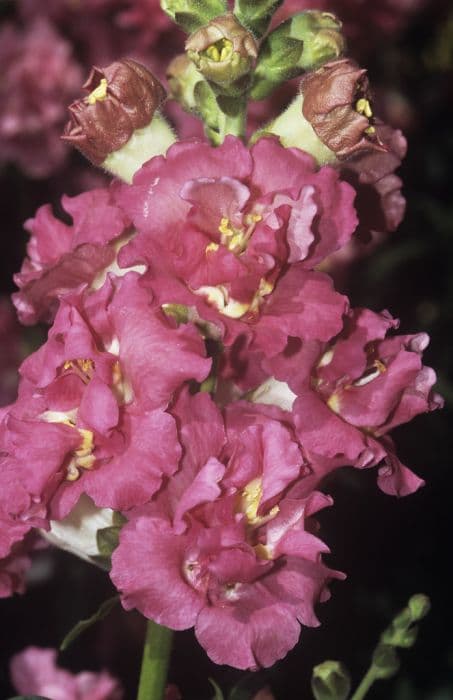Hebe Purple Shamrock Hebe Purple Shamrock = 'Neprock' (PBR) (v)

ABOUT
The Hebe Purple Shamrock 'Neprock' is a striking ornamental plant that is cherished for its beautiful foliage and floral display. The plant sports glossy, evergreen leaves that have a rich purple hue, often with deeper colored edges that can appear almost black. The foliage is tightly packed, forming a dense and neat mound that is both lush and tidy. Throughout the blooming season, the Hebe Purple Shamrock 'Neprock' produces small, vivid purple flowers that add to its allure. These blooms stand out nicely against the dark foliage, creating a stunning contrast that is especially attractive to gardeners looking for a pop of color in their outdoor spaces. The flowers are grouped in clusters, which amplify the visual impact of the plant when it is in full bloom. The overall aesthetic of the Hebe Purple Shamrock 'Neprock' is one of elegance and vibrancy. Its richly colored leaves and contrasting flowers make it a favorite among those who seek to add texture and color to their garden palettes without having to manage a very large plant. The plant can be used effectively in various garden settings, including borders, container displays, and as a standalone focal piece, depending on the gardener's preference. Its appearance is well-suited to both formal and informal garden designs, and it can be a valuable addition to any plant collection.
About this plant
 Names
NamesSynonyms
Purple Shamrock Hebe, Shamrock Hebe, Hebe 'Neprock'.
Common names
Hebe 'Neprock'.
 Toxicity
ToxicityTo humans
The Hebe 'Purple Shamrock' is not widely known for being toxic to humans. However, it is always best to exercise caution and avoid ingesting plants that are not commonly recognized as food, as they can potentially cause adverse reactions. If any part of the plant is ingested, watch for symptoms of gastrointestinal distress such as nausea, vomiting, or diarrhea, and consult a medical professional if symptoms occur.
To pets
The Hebe 'Purple Shamrock' is not widely recognized as a toxic plant to pets. As with humans, ingestion of non-food plants can sometimes lead to gastrointestinal upset in pets, including symptoms such as vomiting or diarrhea. If your pet has ingested part of the plant and is showing signs of distress, it is advisable to contact a veterinarian.
 Characteristics
CharacteristicsLife cycle
Perennials
Foliage type
Evergreen
Color of leaves
Green
Flower color
Purple
Height
2 feet (0.61 meters)
Spread
2 feet (0.61 meters)
Plant type
Shrub
Hardiness zones
8
Native area
New Zealand
Benefits
 General Benefits
General Benefits- Attracts Pollinators: The plant's flowers offer nectar and attract bees, butterflies, and other beneficial insects to the garden.
- Low Maintenance: Hebe 'Neprock' requires minimal care, making it ideal for gardeners looking for plants that do not need a lot of attention.
- Drought Tolerance: Once established, it has a good tolerance for drought conditions, reducing the need for frequent watering.
- Aesthetic Appeal: With its purple foliage and flowers, it provides an attractive splash of color to gardens, borders, and containers.
- Compact Growth: It remains relatively small, making it suitable for gardeners with limited space, or for use in mixed borders without overcrowding.
- Versatility: Suitable for a variety of garden styles, including rock gardens, coastal gardens, and urban settings.
- Winter Interest: Some foliage color persists through winter, helping to add interest to the garden in the colder months.
- Erosion Control: Its root system can help stabilize soil on slopes, helping to prevent soil erosion.
 Medical Properties
Medical PropertiesThis plant is not used for medical purposes.
 Air-purifying Qualities
Air-purifying QualitiesThis plant is not specifically known for air purifying qualities.
 Other Uses
Other Uses- As a natural dye: Hebe flowers and leaves can sometimes be used to create a natural dye for fabrics or crafts, yielding various shades depending on the mordant used.
- In eco-printing: Leaves from the Hebe Purple Shamrock can be used in eco-printing techniques to transfer their shapes and colors onto paper or textiles.
- As a barrier plant: Its dense growth habit can be ideal for creating low, informal hedges or borders to deter foot traffic in sensitive areas of a garden.
- Garden art: Interesting shapes made from trimming Hebe Purple Shamrock can be added as green 'sculptures' in the garden for visual interest.
- In potpourri: Dried Hebe leaves and faded flowers can contribute to the scent and aesthetic of homemade potpourri mixes.
- Culinary garnish: Although not commonly used for consumption, the fresh flowers of Hebe can be used as an edible garnish for their visual appeal on salads and desserts.
- Crafting fairy gardens: Due to their compact size and delicate flowers, these plants can be used to create fairy gardens for a whimsical garden touch.
- Photography prop: The attractive foliage and blooms of Hebe Purple Shamrock can be used as background foliage or as a subject in macro photography.
- Educational tool: This plant can be used in schools or educational programs to teach children about plant growth, pollination, and horticulture.
- Seasonal decoration: Branches and blooms can be used to make natural, biodegradable holiday decorations for events and festivals.
Interesting Facts
 Feng Shui
Feng ShuiThe Hebe plant is not used in Feng Shui practice.
 Zodiac Sign Compitability
Zodiac Sign CompitabilityThe Hebe plant is not used in astrology practice.
 Plant Symbolism
Plant Symbolism- Good Luck: The "Shamrock" in the Hebe Purple Shamrock's name is often associated with good luck and fortune, especially in Irish culture, where the shamrock is a traditional symbol.
- Balance and Harmony: The three leaves of a typical shamrock are sometimes used to symbolize balance in life, as well as harmony between physical, emotional, and spiritual aspects.
- Pride: The vibrant purple hue of the Hebe Purple Shamrock can symbolize pride, dignity, and royalty, reflecting self-confidence and a sense of accomplishment.
 Water
WaterThe Hebe Purple Shamrock should be watered thoroughly, allowing the soil to become moist but not waterlogged. It's important to let the top inch of soil dry out before watering again to prevent root rot. During active growth periods, typically in spring and summer, watering might be necessary once a week, depending on climate conditions. In winter, reduce the watering frequency as the plant's growth slows down. As a guideline, offer the plant approximately one gallon of water every week during the growing season, adjusting as necessary for rainfall and temperature conditions.
 Light
LightHebe Purple Shamrock thrives in full sun to partial shade. Ideally, it should be placed in a location that receives at least six hours of sunlight daily, with some protection from intense afternoon sun which can scorch the leaves. An east or west-facing garden spot would provide the optimal light conditions.
 Temperature
TemperatureHebe Purple Shamrock performs best in temperatures ranging from 50°F to 70°F. This plant can tolerate short periods of colder weather down to about 30°F, but it should be protected from frost. The ideal temperature range allows the plant to grow robustly without the stress of extreme heat or cold.
 Pruning
PruningPruning Hebe Purple Shamrock helps to maintain its shape and encourage bushier growth. Prune in the early spring before new growth appears, cutting back any damaged or overgrown stems. This plant benefits from occasional light pruning rather than severe cuts, which can be performed once or twice a year as needed to keep it tidy.
 Cleaning
CleaningAs needed
 Soil
SoilThe best soil mix for Shamrock Hebe is a well-draining, loamy mixture with some added peat or compost for richness. Aim for a slightly acidic to neutral pH between 6.0 and 7.0 for optimal growth.
 Repotting
RepottingShamrock Hebe should be repotted every 2 to 3 years to refresh the soil and accommodate root growth or as needed if the plant shows signs of being root-bound.
 Humidity & Misting
Humidity & MistingShamrock Hebe prefers moderate to high humidity levels but is adaptable and can tolerate a range of conditions as long as it is not too dry for extended periods.
 Suitable locations
Suitable locationsIndoor
Provide bright indirect light, moderate watering, and well-draining soil.
Outdoor
Plant in a sunny spot, shelter from harsh winds, ensure well-draining soil.
Hardiness zone
7-10 USDA
 Life cycle
Life cycleThe Hebe Purple Shamrock, commonly known as Shrubby Veronica, begins its life cycle with seed germination, which is less common in cultivated varieties like 'Neprock' and often propagated through cuttings. The cuttings, taken from healthy adult plants, quickly form roots when placed in a suitable growing medium. Once rooted, the young Hebe plants enter a vegetative growth phase, developing a bushy structure with glossy green leaves and distinctive purple edges. Upon reaching maturity, the Hebe Purple Shamrock produces small, clustered flowers typically in shades of purple or pink during the summer months, attracting pollinators to its blooms. After pollination, seed formation may occur, though cultivated varieties might not set seeds true to parent type. As the seasons change, this evergreen shrub may experience a dormancy phase during colder months but generally maintains its foliage year-round, entering a new growth cycle in the spring.
 Propogation
PropogationPropogation time
Spring-Early Summer
Hebe 'Purple Shamrock', also known as Neprock, is typically propagated by softwood cuttings. The most popular method for propagating this Hebe variety is to take cuttings from the current season's growth. This is best done in late spring or early summer when the stems are mature enough yet still flexible. To do this, cut a 4 to 6 inch-long (10 to 15 cm) stem segment from the plant, making sure it has several sets of leaves. Remove the lower leaves and dip the cut end of the stem into a rooting hormone for better results. The cutting is then placed in a well-draining potting mix, watered gently, and covered with plastic to retain humidity. The cutting should root in several weeks, at which point it can be hardened off and eventually transplanted outside.





![Snapdragon [Pretty in Pink]](/_next/image?url=https%3A%2F%2Fplants-admin.emdemapps.com%2Fimages%2Fplants%2F%2Fimages%2F604b5cb3b5385.png&w=640&q=75)



